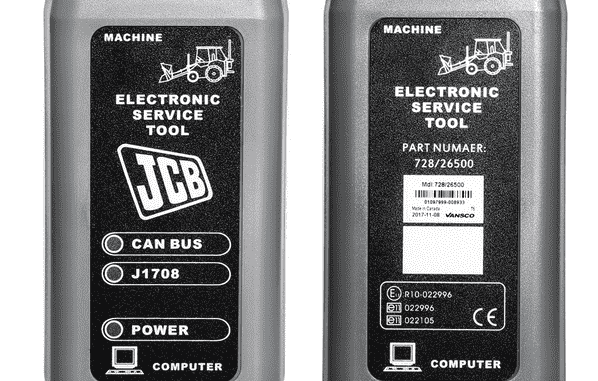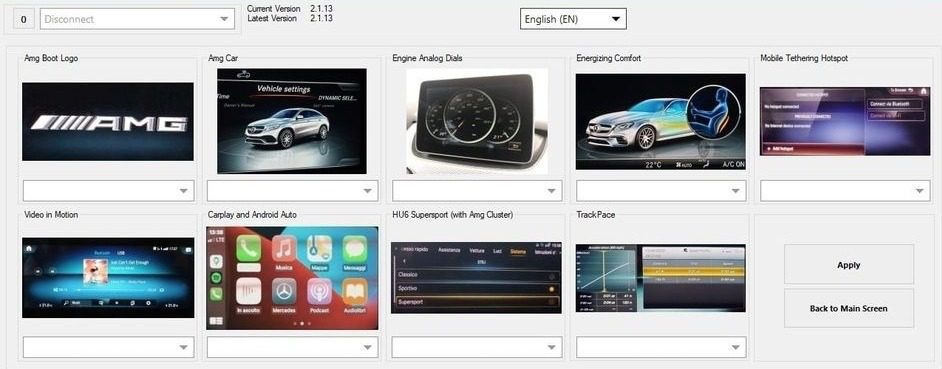
JCB (Joseph Cyril Bamford) is a well-known manufacturer of construction, agriculture, and industrial equipment.
1. User-Friendly Interface:
The user-friendly interface of the JCB Diagnostic Tool is a key factor that sets it apart in the realm of heavy machinery maintenance. This interface is thoughtfully designed to cater to the diverse needs of both seasoned technicians and operators with varying levels of expertise. Here are some aspects that highlight the user-friendly nature of the JCB Diagnostic Tool interface:
1.1 Intuitive Design:
The interface is built with an intuitive design that simplifies navigation. Clear and logically organized menus ensure that users can easily access the specific features or information they need without unnecessary complications. This intuitive design contributes to a seamless user experience.
1.2 Graphical Representation:
The inclusion of graphical representations of data enhances the tool’s usability. Live data from various sensors are presented in a visually comprehensible format, allowing users to quickly grasp the performance status of the machinery. Graphs, charts, and visual indicators aid in the efficient interpretation of diagnostic information.
1.3 Straightforward Navigation:
The tool features straightforward navigation, minimizing the learning curve for users. Whether accessing real-time data, interpreting fault codes, or making parameter adjustments, the navigation is designed to be user-friendly. This simplicity is crucial in ensuring that operators and technicians can effectively utilize the tool without unnecessary complexity.
1.4 Customizable Settings:
Recognizing that different users may have distinct preferences, the JCB Diagnostic Tool offers customizable settings. Users can personalize their interface preferences, adjusting layouts or display options based on their individual needs. This level of customization enhances user comfort and ensures that the tool can be tailored to suit the preferences of various operators and technicians.
1.5 Contextual Help and Documentation:
To further support users, the interface includes contextual help and documentation features. Users can access relevant information or instructions directly from the interface, providing assistance when needed. This feature is particularly beneficial for users who may encounter unfamiliar terms or procedures during diagnostics or maintenance tasks.
1.6 Compatibility Across Devices:
The JCB Diagnostic Tool is designed to be compatible across various devices, including tablets and laptops. This flexibility allows users to choose the device that best suits their preferences or work environment. The consistent interface across devices ensures a seamless transition for users, maintaining the user-friendly experience regardless of the chosen platform.
2. Enhanced Troubleshooting Efficiency:
The JCB Diagnostic Tool stands out for its ability to significantly enhance troubleshooting efficiency in the maintenance of JCB machinery. This tool is equipped with features and capabilities that streamline the diagnostic process, allowing technicians to identify and address issues swiftly. Here are key aspects that contribute to the enhanced troubleshooting efficiency of the JCB Diagnostic Tool:
2.1 Detailed Diagnostic Reports:
The tool generates detailed diagnostic reports that provide comprehensive insights into the health of JCB machinery. These reports go beyond surface-level information, offering technicians a deeper understanding of the system’s performance. This depth of analysis facilitates precise issue identification and targeted troubleshooting.
2.2 Real-time Data Monitoring:
The JCB Diagnostic Tool enables real-time monitoring of data from various sensors on the machinery. This live data stream allows technicians to observe the equipment’s performance as it happens. Immediate access to real-time information is invaluable for quickly identifying abnormalities or deviations from optimal operating conditions.
2.3 Fault Code Reading and Interpretation:
A key feature of the tool is its ability to read and interpret fault codes. When an issue arises, the tool can identify and communicate specific fault codes associated with the problem. This capability accelerates the troubleshooting process, enabling technicians to pinpoint the root cause of an issue without extensive manual inspection.
2.4 Swift Issue Identification:
The JCB Diagnostic Tool’s advanced algorithms and diagnostics algorithms facilitate swift issue identification. Technicians can leverage the tool to analyze complex data sets and rapidly identify potential problems. This efficiency is crucial for reducing downtime, as it allows for quicker decision-making and implementation of necessary repairs.
2.5 Graphical Data Representation:
Graphical representation of diagnostic data enhances the tool’s usability. Technicians can visualize trends, fluctuations, and anomalies in the machinery’s performance through graphs and charts. This visual approach aids in quickly spotting irregularities and understanding the dynamics of the equipment’s operation, contributing to faster issue resolution.
2.6 Remote Diagnostics Capabilities:
The tool offers remote diagnostics capabilities, allowing technicians to assess the machinery’s status even when not physically present at the site. This feature is particularly beneficial for troubleshooting issues in real-time, providing a swift response to problems without the need for on-site visits. Remote diagnostics contribute to minimizing downtime and optimizing maintenance efficiency.
2.7 Integration with Service and Maintenance Information:
The JCB Diagnostic Tool integrates seamlessly with service and maintenance information. This integration ensures that technicians have access to step-by-step instructions and relevant details for addressing identified issues. The tool becomes a comprehensive resource, guiding technicians through the troubleshooting and repair processes.
3. Connectivity and Compatibility:
The JCB Diagnostic Tool stands out not only for its advanced diagnostic capabilities but also for its impressive connectivity and compatibility features. These aspects contribute significantly to its effectiveness in maintaining and troubleshooting JCB machinery. Here’s a closer look at the connectivity and compatibility aspects of the JCB Diagnostic Tool:
3.1 Versatile Compatibility:
The JCB Diagnostic Tool is designed to be compatible with a wide range of JCB machinery. This versatility makes it a valuable asset for fleet maintenance, as it can be used across various models and types of JCB equipment. The tool’s compatibility across different machines simplifies the diagnostic and maintenance process for businesses with diverse fleets.
3.2 Communication with Electronic Control Systems:
The tool establishes seamless communication with the electronic control systems of JCB machinery. This connectivity is crucial for accessing real-time data, reading fault codes, and making parameter adjustments. The effective communication with the equipment’s electronic systems ensures that the diagnostic tool can perform its functions accurately and comprehensively.
3.3 Consistent Interface Across Models:
Regardless of the specific JCB model, the JCB Diagnostic Tool provides a consistent interface. This uniformity ensures that technicians and operators can use the tool with familiarity across different machines. The standardized interface contributes to ease of use and reduces the learning curve, allowing users to transition smoothly between various JCB models.
3.4 Adaptability to Technological Changes:
In the rapidly evolving landscape of heavy machinery technology, the JCB Diagnostic Tool is designed to adapt to technological changes. This adaptability is crucial for ensuring that the tool remains relevant and effective as JCB continues to introduce new features and advancements in its machinery. Regular updates and compatibility enhancements keep the tool in sync with the latest developments.
3.5 Device Compatibility:
The JCB Diagnostic Tool is designed to be compatible with a variety of devices, including laptops and tablets. This flexibility allows users to choose the device that best suits their preferences and work environments. The tool’s adaptability to different devices ensures that technicians can carry out diagnostics and maintenance tasks using the equipment they are most comfortable with.
3.6 Integration with Other Maintenance Systems:
The connectivity features of the JCB Diagnostic Tool extend beyond the tool itself. It can integrate with other maintenance systems, enhancing overall workflow efficiency. This integration allows for a seamless exchange of information between the diagnostic tool and broader maintenance management systems, contributing to a holistic approach to machinery maintenance.
4. Remote Diagnostics and Support:
The JCB Diagnostic Tool’s capability for remote diagnostics and support is a pivotal feature that adds significant value to the maintenance and operation of JCB machinery. This functionality leverages modern connectivity to provide technicians with real-time access to crucial data, enabling them to diagnose issues and offer support even when physically distant from the machinery site. Here are key aspects that highlight the importance and benefits of remote diagnostics and support offered by the JCB Diagnostic Tool:
4.1 Real-Time Data Access:
Remote diagnostics empower technicians to access real-time data from JCB machinery, allowing them to monitor performance, analyze live parameters, and identify potential issues. This immediate access to data is essential for making informed decisions and diagnosing problems promptly.
4.2 Swift Issue Resolution:
The ability to perform remote diagnostics facilitates swift issue resolution. Technicians can analyze diagnostic reports, interpret fault codes, and troubleshoot problems without the need to be on-site. This expeditious approach minimizes downtime and contributes to a more efficient maintenance process.
4.3 Timely Decision-Making:
Remote diagnostics enable timely decision-making, as technicians can assess the situation quickly and decide on the appropriate course of action. Whether it involves adjusting parameters, initiating repairs, or providing guidance to on-site personnel, remote access ensures that decisions are made promptly to address maintenance needs.
4.4 Reduced Downtime:
By enabling remote diagnostics and support, the JCB Diagnostic Tool contributes to minimizing machinery downtime. Technicians can intervene rapidly to address issues, preventing prolonged periods of inactivity that could result in productivity losses for businesses relying on JCB equipment.
4.5 Cost Savings:
Remote diagnostics offer cost savings by reducing the need for on-site visits. Technicians can diagnose and resolve issues remotely, eliminating travel costs and saving time associated with reaching the machinery site. This cost-effective approach enhances the overall economic efficiency of machinery maintenance.
4.6 Global Accessibility:
The remote diagnostics feature of the JCB Diagnostic Tool allows technicians to provide support from virtually anywhere in the world. This global accessibility is particularly valuable for businesses with machinery deployed across diverse geographic locations. Technicians can offer support and expertise without the constraints of physical proximity.
4.7 Enhanced Collaboration:
Remote diagnostics facilitate collaboration between technicians, operators, and maintenance teams. Even if team members are not co-located, they can work together to analyze data, share insights, and collectively determine the best course of action. This collaborative approach contributes to more effective and comprehensive issue resolution.
4.8 Training and Guidance:
Remote support extends beyond issue resolution to include training and guidance. Technicians can remotely guide on-site personnel through maintenance procedures, ensuring that tasks are performed correctly. This aspect of remote support contributes to skill development and knowledge transfer within maintenance teams.
5. Cost-Effective Maintenance:
The cost-effectiveness of the JCB Diagnostic Tool plays a crucial role in optimizing maintenance practices for JCB machinery. This diagnostic tool is designed to not only identify and troubleshoot issues efficiently but also to contribute to long-term cost savings for equipment owners. Here are key aspects that highlight the cost-effective nature of maintenance with the JCB Diagnostic Tool:
5.1 Proactive Maintenance:
The JCB Diagnostic Tool facilitates proactive maintenance by providing real-time data and diagnostic insights. Technicians can monitor the health of JCB machinery continuously, allowing them to identify potential issues before they escalate into major problems. This proactive approach helps prevent costly breakdowns and reduces the need for extensive repairs or component replacements.
5.2 Swift Issue Identification:
The tool’s advanced diagnostic capabilities enable technicians to swiftly identify issues. By quickly pinpointing the root cause of a problem, technicians can expedite the troubleshooting process, reducing the time machinery spends in downtime. Swift issue identification is instrumental in minimizing the overall cost of maintenance.
5.3 Minimized Downtime:
The JCB Diagnostic Tool contributes to minimizing machinery downtime, which is a critical factor in cost-effective maintenance. Rapid issue resolution, made possible by the tool’s capabilities, ensures that equipment can resume operations promptly. Reduced downtime translates into increased productivity and revenue for businesses relying on JCB machinery.
5.4 Prevention of Major Breakdowns:
By allowing technicians to address issues before they escalate, the JCB Diagnostic Tool plays a key role in preventing major breakdowns. Major failures can result in extensive repair costs and lengthy downtime. The tool’s ability to catch and resolve issues early helps equipment owners avoid these significant expenses.
5.5 Optimized Performance through Adjustments:
The tool enables technicians to make parameter adjustments to optimize machine performance based on specific requirements. This capability ensures that JCB machinery operates at its peak efficiency, contributing to fuel savings and overall operational cost reductions. Adjusting parameters based on real-time data ensures that the equipment is tailored to current operating conditions.
5.6 Remote Diagnostics for Timely Support:
The remote diagnostics and support feature of the JCB Diagnostic Tool further enhances cost-effectiveness. Technicians can provide support and diagnostics remotely, eliminating the need for on-site visits. This reduces travel costs and ensures that issues are addressed promptly, regardless of the geographic location of the machinery.
5.7 Extended Equipment Lifespan:
By promoting proactive maintenance practices and preventing major breakdowns, the JCB Diagnostic Tool contributes to extending the lifespan of JCB machinery. Equipment that is well-maintained and operates efficiently over a more extended period represents a substantial return on investment for equipment owners.
5.8 Reduced Unplanned Maintenance Costs:
The tool’s ability to facilitate proactive, planned maintenance helps in reducing unplanned maintenance costs. Unplanned breakdowns often result in emergency repairs, which can be more expensive and time-consuming. The JCB Diagnostic Tool helps minimize the occurrence of unplanned maintenance events.
With the JCB Diagnostic Tool, the path to efficient and cost-effective machinery maintenance is paved, contributing to increased productivity and minimized downtime in the dynamic world of heavy equipment operations.










